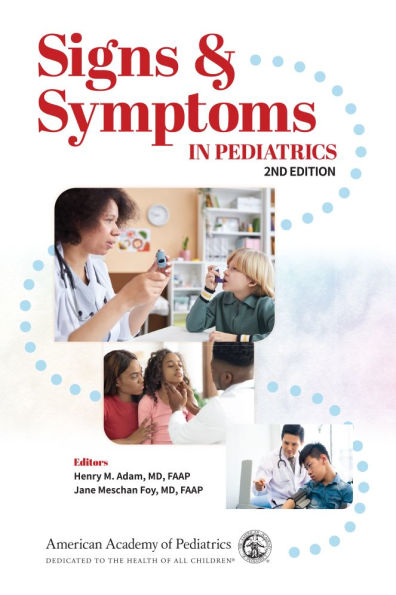This practice-focused resource provides must-know information and expert advice for confidently addressing more than 80 diagnostic challenges.
Over 100 full-color images complement the concise text!
Look here for the essentials on everything from abdominal, back, and chest pain...to fever, fatigue, headache, and heart murmurs...to rash, red eye, sleep disturbances, and speech and language concerns...plus much more. Coverage also extends to evaluation of mental health symptoms, including anxiety, depression, disruptive behavior, emotional disturbance, inattention and impulsivity, and self-injury.
Contents Include:
1. Abdominal Distention
2. Abdominal Pain
3. Alopecia and Hair Shaft Anomalies
4. Amenorrhea
5. Anemia and Pallor
6. Anxiety and Trauma-related Distress
7. Ataxia
8. Back Pain
9. Cardiac Arrhythmias
10. Chest Pain
11. Constipation
12. Cough
13. Cyanosis
14. Depressive Symptoms
15. Diarrhea and Steatorrhea
16. Disruptive Behavior and Aggression
17. Dizziness and Vertigo
18. Dysmenorrhea
19. Dysphagia
20. Dyspnea
21. Dysuria
22. Edema
23. Epistaxis
24. Extremity Pain
25. Facial Dysmorphism
26. Failure to Thrive: Pediatric Undernutrition
27. Families with Functional Impairments
28. Fatigue and Weakness
29. Fever
30. Fever of Unknown Origin
31. Foot and Leg Problems
32. Gastrointestinal Hemorrhage
33. Headache
34. Hearing Loss
35. Heart Murmurs
36. Hematuria
37. Hemoptysis
38. Hepatomegaly
39. High Blood Pressure
40. Hirsutism, Hypertrichosis, and Precocious Sexual Hair Development
41. Hoarseness
42. Hyperhidrosis
43. Hypotonia
44. Inattention and Impulsivity
45. Irritability and Fussiness
46. Jaundice
47. Joint Pain
48. Learning Difficulty
49. Limp
50. Loss of Appetite
51. Lymphadenopathy
52. Macrocephaly
53. Medically Unexplained Symptoms
54. Microcephaly
55. Nonconvulsive Periodic Disorders
56. Odor (Unusual Urine and Body)
57. Petechiae and Purpura
58. Polyuria
59. Proteinuria
60. Pruritus
61. Puberty: Normal and Abnormal
62. Rash
63. Recurrent Infections
64. Red Eye/Pink Eye
65. School Absenteeism and School Refusal
66. Scrotal Swelling and Pain
67. Self-injury
68. Self-stimulating Behaviors
69. Short Stature
70. Sleep Disturbances (Nonspecific)
71. Speech and Language Concerns
72. Splenomegaly
73. Stress in Gender Diverse Youth
74. Stridor
75. Substance Use: The Role of the Pediatrician
76. Symptoms of Emotional Disturbance in Children Younger than 5 Years
77. Symptoms of Emotional Disturbance in Children Older than 5 Years
78. Syncope
79. Temper Tantrums and Breath-holding Spells
80. Tics
81. Torticollis
82. Vaginal Bleeding
83. Vaginal Discharge
84. Vomiting
85. Weight Loss
86. Wheezing
This practice-focused resource provides must-know information and expert advice for confidently addressing more than 80 diagnostic challenges.
Over 100 full-color images complement the concise text!
Look here for the essentials on everything from abdominal, back, and chest pain...to fever, fatigue, headache, and heart murmurs...to rash, red eye, sleep disturbances, and speech and language concerns...plus much more. Coverage also extends to evaluation of mental health symptoms, including anxiety, depression, disruptive behavior, emotional disturbance, inattention and impulsivity, and self-injury.
Contents Include:
1. Abdominal Distention
2. Abdominal Pain
3. Alopecia and Hair Shaft Anomalies
4. Amenorrhea
5. Anemia and Pallor
6. Anxiety and Trauma-related Distress
7. Ataxia
8. Back Pain
9. Cardiac Arrhythmias
10. Chest Pain
11. Constipation
12. Cough
13. Cyanosis
14. Depressive Symptoms
15. Diarrhea and Steatorrhea
16. Disruptive Behavior and Aggression
17. Dizziness and Vertigo
18. Dysmenorrhea
19. Dysphagia
20. Dyspnea
21. Dysuria
22. Edema
23. Epistaxis
24. Extremity Pain
25. Facial Dysmorphism
26. Failure to Thrive: Pediatric Undernutrition
27. Families with Functional Impairments
28. Fatigue and Weakness
29. Fever
30. Fever of Unknown Origin
31. Foot and Leg Problems
32. Gastrointestinal Hemorrhage
33. Headache
34. Hearing Loss
35. Heart Murmurs
36. Hematuria
37. Hemoptysis
38. Hepatomegaly
39. High Blood Pressure
40. Hirsutism, Hypertrichosis, and Precocious Sexual Hair Development
41. Hoarseness
42. Hyperhidrosis
43. Hypotonia
44. Inattention and Impulsivity
45. Irritability and Fussiness
46. Jaundice
47. Joint Pain
48. Learning Difficulty
49. Limp
50. Loss of Appetite
51. Lymphadenopathy
52. Macrocephaly
53. Medically Unexplained Symptoms
54. Microcephaly
55. Nonconvulsive Periodic Disorders
56. Odor (Unusual Urine and Body)
57. Petechiae and Purpura
58. Polyuria
59. Proteinuria
60. Pruritus
61. Puberty: Normal and Abnormal
62. Rash
63. Recurrent Infections
64. Red Eye/Pink Eye
65. School Absenteeism and School Refusal
66. Scrotal Swelling and Pain
67. Self-injury
68. Self-stimulating Behaviors
69. Short Stature
70. Sleep Disturbances (Nonspecific)
71. Speech and Language Concerns
72. Splenomegaly
73. Stress in Gender Diverse Youth
74. Stridor
75. Substance Use: The Role of the Pediatrician
76. Symptoms of Emotional Disturbance in Children Younger than 5 Years
77. Symptoms of Emotional Disturbance in Children Older than 5 Years
78. Syncope
79. Temper Tantrums and Breath-holding Spells
80. Tics
81. Torticollis
82. Vaginal Bleeding
83. Vaginal Discharge
84. Vomiting
85. Weight Loss
86. Wheezing

Signs & Symptoms in Pediatrics
900
Signs & Symptoms in Pediatrics
900Paperback(2nd ed.)

Product Details
| ISBN-13: | 9781610028202 |
|---|---|
| Publisher: | American Academy of Pediatrics |
| Publication date: | 10/01/2025 |
| Edition description: | 2nd ed. |
| Pages: | 900 |
| Product dimensions: | 6.00(w) x 9.00(h) x 0.00(d) |
